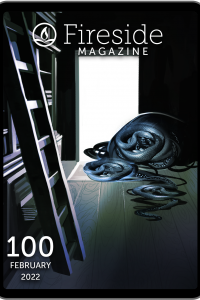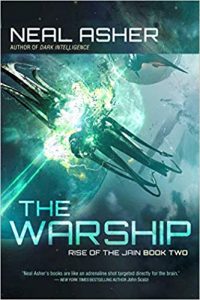The Way by Cary Groner: Review by Ian Mond
 The Way, Cary Groner (Spiegel & Grau 978-1-95411-842-3, $29.00, 304pp, hc) December 2024.
The Way, Cary Groner (Spiegel & Grau 978-1-95411-842-3, $29.00, 304pp, hc) December 2024.
In Cary Groner’s second novel, The Way, a heavily mutated and infectious avian flu wipes out 80 percent of humanity. The event, dubbed ‘‘Mayhem’’ by the survivors, leads to the expected breakdown of civilisation – ‘‘starvation; migration; a brief, limited nuclear exchange; then finally the return of endemic diseases like TB, diphtheria, typhoid, cholera, malaria, and plague’’ – but also the emergence of a new pathogen, ‘‘Disease X,’’ which lies dormant until a person hits their forties, eating away at their sanity until they die. Will Collins is 52 years old, yet to feel the bite of Disease X. Once a science writer, haunted by his wife’s death, he has spent the last fifteen years alone as the caretaker of a dharma centre in Colorado. An unexpected message from an old scientist friend has Will leave the relative safety of Colorado for California. There, he will hand over a possible cure to Disease X, contained in a tiny ampoule, ‘‘a tenth of the size of my smallest fingernail’’ secreted inside his body (he hasn’t been told where). But Will’s survival is not assured. Postapocalyptic challenges aside, the leader of the American Revolutionary Militia, ‘‘a brute named Flynn,’’ is on Will’s heels, desperate to get his hands on the cure. All Will has on his side are his wits, two hardworking mules, and the companionship of Peau the raven and Cassie the cat, with whom he can communicate. Yes. I might have buried the lede. Will can talk to and understand the language of his raven and cat.
Before 2020, the killer virus novel and films – like The Stand, Station Eleven (which The Way has been compared to), Oryx and Crake, The Outbreak and Contagion – acted as a cautionary tale, a fearful (and vicarious) reminder that something as microscopic as a virus could bring down civilisation. Initially, people were drawn to these works at the height of the pandemic as if they might prophesize what was to come. But once the tedium and ever-present anxiety of lockdown kicked in, those books and movies lost their lustre. Four years later, there is something almost naïve about those pre-COVID works, especially the novels, and how quickly they jump straight to the roving, violent gangs, the charismatic-cultlike leaders and the breakdown of civilisation, skipping all the boredom, misinformation, and celebrities singing ‘‘Imagine’’. As Charles Stross said after he abandoned a zombie epidemic novel at the height of the pandemic, ‘‘COVID-19 came along and basically rendered the whole thing unnecessary because we are all getting a real world crash course in how we deal with people suffering from a viral pandemic.’’
That’s my issue with The Way. While Groner briefly acknowledges COVID (the forerunner to the mutated avian flu and Disease X), the novel reads like the product of a different time, one where worldwide pandemics were the subject of history (Dafoe, the Influenza pandemic of 1918-19) and the imagination. It’s not that the killer virus (or zombie epidemic) as a subgenre no longer has a place, but that the bar is now so much higher. Take Ling Ma’s Severance, written at the cusp of the pandemic. It still resonates with me because it uses its world-ending virus (originating rather presciently from China) to uniquely explore late-stage capitalism and the immigrant experience. The Way struggles, in my view, to reach a similar watermark because it leans so heavily on well-worn tropes of the past – the armed militias, the collapse of critical infrastructure, the fight for resources – and resembles more recent killer virus fare such as The Last of Us. Not only is Will, much like Joel, transporting and protecting a possible cure for a disease, but around a third of the way through the narrative, he becomes the reluctant guardian of Sophie, who, similar to Ellie, is a hardened and cynical fourteen-year-old who faces a precarious future. Even the trajectory of their relationship is reminiscent of the father/daughter bond that forms between Joel and Ellie.
All this isn’t to say that I didn’t enjoy aspects of The Way. It’s nice to have a hero in his fifties who is a pacifist and is wracked with guilt when forced to resort to violence. Peau and Cassie are a fantastic double act. They give the novel a welcome tinge of weirdness while reinforcing the importance of friendship and love even as the world falls apart. There are also several standout cinematic set-pieces, including a thrilling sequence involving two trains, a tunnel, and the possibility that the line might give out at any time. For me, though, these elements aren’t enough to differentiate The Way from so many killer virus novels that have come before it, works written before we had an inkling of what a pandemic might be like.
Interested in this title? Your purchase through the links below brings us a small amount of affiliate income and helps us keep doing all the reviews you love to read!
Ian Mond loves to talk about books. For eight years he co-hosted a book podcast, The Writer and the Critic, with Kirstyn McDermott. Recently he has revived his blog, The Hysterical Hamster, and is again posting mostly vulgar reviews on an eclectic range of literary and genre novels. You can also follow Ian on Twitter (@Mondyboy) or contact him at mondyboy74@gmail.com.
This review and more like it in the December 2024 issue of Locus.
 While you are here, please take a moment to support Locus with a one-time or recurring donation. We rely on reader donations to keep the magazine and site going, and would like to keep the site paywall free, but WE NEED YOUR FINANCIAL SUPPORT to continue quality coverage of the science fiction and fantasy field.
While you are here, please take a moment to support Locus with a one-time or recurring donation. We rely on reader donations to keep the magazine and site going, and would like to keep the site paywall free, but WE NEED YOUR FINANCIAL SUPPORT to continue quality coverage of the science fiction and fantasy field.
©Locus Magazine. Copyrighted material may not be republished without permission of LSFF.









